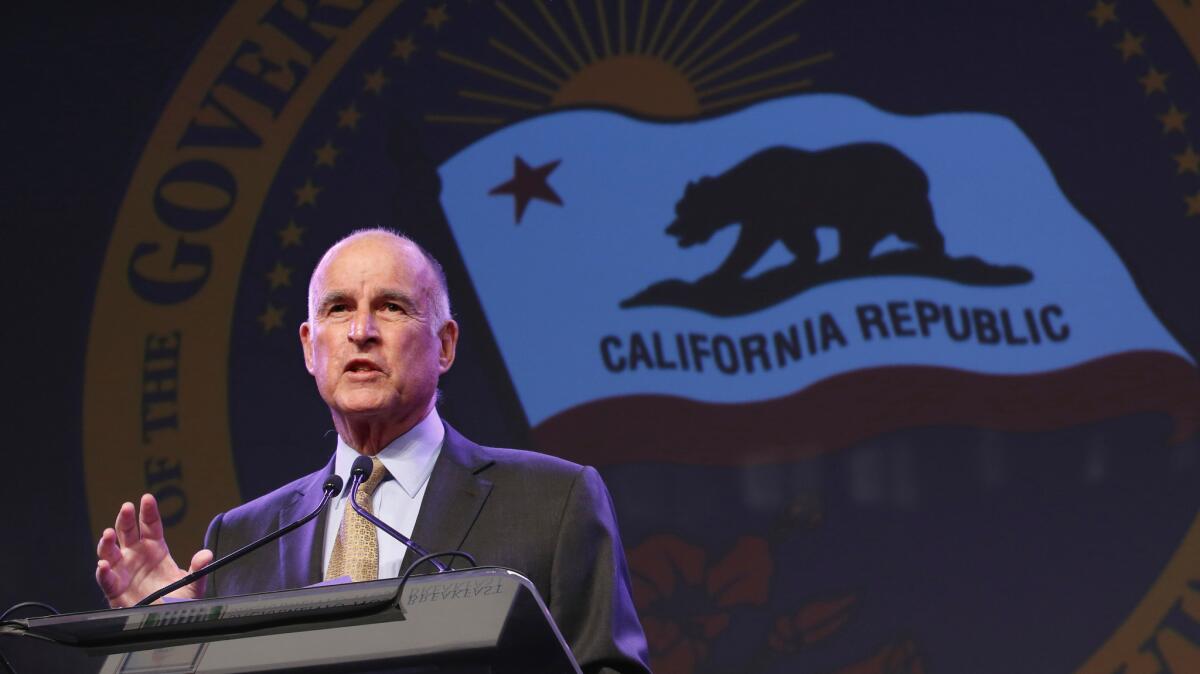Capitol Journal: Does Gov. Brown want to save the planet or his choo-choo?

- Share via
Reporting from Sacramento — Gov. Jerry Brown needs to decide: Which does he really want to save? Our planet Earth? Or his choo-choo?
He can’t handle both — at least not in the few days remaining before the Legislature wraps up its two-year session Aug. 31. And maybe never.
The dirty truth is that California’s governor, with the legislators’ permission, has been using his high-profile battle against global warming to generate money needed to keep alive the unpopular bullet train project.
But that scheme appears to be headed for a derailment.
Brown has been asking the Legislature for a total fix that would spare the train. But there isn’t enough legislative support for that, even among fellow Democrats.
There might be ample votes for a temporary patch-up to keep the project chugging for another year or two. Maybe.
“Jerry Brown needs to wake up, drink a cup of coffee and get to work,” says one Democrat, echoing the thoughts of many Capitol insiders who don’t want to be publicly identified as critics of the governor.
“His office’s actions these past months have been a disaster when it comes to leadership on this issue.”
The issue is a mishmash of political complexity. The basics are these:
Encouraged by Gov. Arnold Schwarzenegger, voters approved $9 billion in state bonds for high-speed rail in 2008. President Obama and Congress added $3.5 billion in rail money as economic stimulus. But federal funding dried up when Republicans took over Congress. And private investors have snubbed the $64-billion project.
Brown has kept it afloat with money generated by his fight against global warming. It involves a cap-and-trade program that controls greenhouse gas emissions. The state peddles permits to pollute and pumps 25% of the profits into high-speed rail.

Gov. Jerry Brown of California speaks at the Democratic National Convention. More coverage at latimes.com/trailguide.
But that convenient combo of saving both the planet and the bullet train is legally suspect.
The California Chamber of Commerce sued, claiming the cap-and-trade pollution peddling amounted to a tax and therefore required a two-thirds legislative vote. The 2006 anti-global-warming act was passed on only a simple majority vote.
A state appeals court has indicated it may be siding with the chamber. Anyway, that’s how legal experts are reading the case.
Brown’s privately nervous. The law is slated to expire in 2020. And he wants it extended until 2030, significantly strengthened and passed on a two-thirds vote.
Forget the two-thirds, legislative leaders say. Can’t happen. Public support for the bullet train has deteriorated.
First the project was scaled back. San Diego and Sacramento were eliminated as destinations. Now it’s merely a Los Angeles-to-San Francisco route, starting with only a short line in San Joaquin Valley farm fields.
Also, the cost doubled from what voters were promised.
There have been years of delays. And the train won’t be all that high-speed after all.
With gubernatorial cajoling, coercing and compromise, however, there may be — it’s conceivable — enough support in the Legislature to pass a less ambitious bill on a simple majority vote.
It would extend the anti-global warming act to 2030 and set a goal of cutting greenhouse emissions by 40% below 1990 levels. The original act established a target of reducing emissions to 1990 levels by 2020. And that has practically been achieved.
The act’s extension, however, wouldn’t mention cap-and-trade or high-speed rail. Those are red flags. The Legislature would delay that debate until next year or later. So future train funding would be sidetracked. The revenue flow already has plummeted because of cap-and-trade’s uncertainty.
Publicly, Brown professes not to worry.
“We are going to extend our climate goals and cap-and-trade one way or another,” his top aide, Nancy McFadden, boldly proclaimed recently. “This year, next year or on the ballot in 2018.”
That produced Capitol snickers. A ballot measure in 2018, the year Brown will be termed-out, would inescapably become a referendum on high-speed rail. That’s not a prospect any departing governor should relish, even one as popular as Brown.
“If the state had $50 billion to spend, would we want to spend it on a train from San Jose to Bakersfield?” state chamber President Allan Zaremberg asks rhetorically. “I’m all for spending money on improving transportation in Los Angeles and San Francisco, but….”
Answer: Probably not.
On Wednesday, Senate leader Kevin de León (D-Los Angeles) — trying to rally support for an extension of the anti-global-warming act — unveiled a legislative package aimed at spending $1.2 billion in cap-and-trade funds not reserved for the train.
The legislation would “use polluters’ dollars to clean up the air we breathe,” he said.
Proposed projects would help heavily polluted and low-income communities, plus small businesses, nonprofits, agriculture and water facilities. But there’d be no additional money for the bullet train.
If Brown lobbies legislators and focuses, he probably can extend the anti-global-warming act. If not, he’ll likely suffer a black eye nationally.
Then next year — perhaps when Democrats recapture supermajority control of the Legislature after Donald Trump sours voters on Republicans — Brown can renegotiate another way to finance his bullet train.
Something less convoluted than cap-and-trade.
Politics, after all, is the art of the possible. That’s how it was defined by 19th century German Chancellor Otto von Bismarck.
Brown certainly understands this. He needs to have that coffee.
Follow @LATimesSkelton on Twitter
ALSO
While cap-and-trade funds stay mired in debate, businesses feel the hit
Gov. Jerry Brown brings his climate crusade to the DNC stage
With climate legislation stalling, Jerry Brown looks to potential fight at the ballot box
More to Read
Get the L.A. Times Politics newsletter
Deeply reported insights into legislation, politics and policy from Sacramento, Washington and beyond. In your inbox three times per week.
You may occasionally receive promotional content from the Los Angeles Times.











